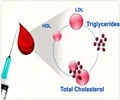A new study is shedding light on how drug Zetia, used to treat high cholesterol, blocks cholesterol absorption from the diet.
Zetia, the drug used to treat high cholesterol, works by blocking cholesterol absorption from the diet, a new study has found.
Ezetimibe, also known as Zetia is the only drug that cuts the amount of cholesterol taken in from the diet rather than by blocking cholesterol's manufacture in the body.The researchers have shown how protein known as Niemann-Pick C1-like 1 (NPC1L1) carries cholesterol into the cell.
They also show that ezetimibe bars NPC1L1's entry into the cell, thereby keeping cholesterol at bay.
In previous studies, scientists identified NPC1L1 as a critical player in cholesterol's absorption.
They also found that mice lacking this protein stop responding to ezetimibe drug. While there were clues that the drug interacts directly with the cholesterol absorption protein, the details remained unclear.
The team led by Bao-Liang Song of Shanghai Institutes for Biological Sciences now finds that cholesterol specifically encourages cells to engulf and internalize NPC1L1 in a process known as endocytosis.
Advertisement
By preventing NPC1L1's entry into the cell, the researchers showed they could dramatically reduce the amount of cholesterol taken up by cells. zetimibe accomplishes that by preventing NPC1L1 from incorporating into vesicles.
Advertisement
"Now we see how NPC1L1 is recycled between the cell surface and vesicles [inside the cell] and how it takes in cholesterol," Song added.
Though ezetimibe can dramatically decrease blood cholesterol concentrations in some people, it is barely effective in others, the researchers said.
Therefore there is an urgent need for more cholesterol uptake inhibitory drugs. Our work provides the molecular basis for developing additional cholesterol absorption inhibitors.
"Moreover, the cell-based assay that we have established can potentially be used to screen for novel inhibitors of NPC1L1 endocytosis, which will block cholesterol uptake eventually," Song added.
The study appears in June issue of Cell Metabolism, a Cell Press publication.
Source-ANI
RAS/L










